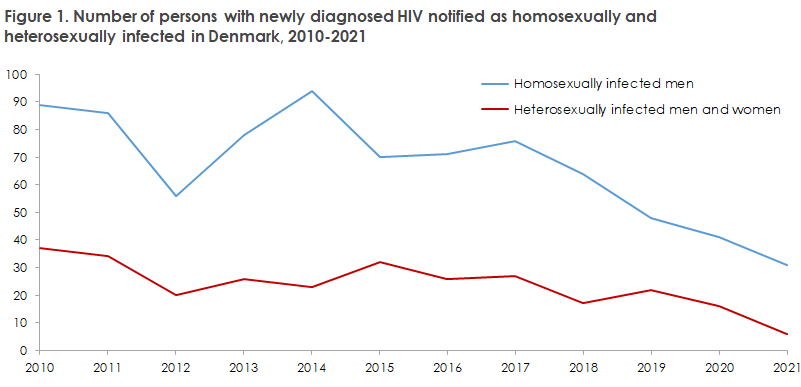No 48 - 2022
HIV 2021
HIV 2021
2021 saw a total of 132 notified cases of HIV, including 109 men and 23 women. Among these 132 notified cases, 51 persons (39%) had previously been diagnosed with HIV abroad, including two persons born in Denmark.
For a detailed epidemiological description of the 2021 incidence, please see the 2021 Annual HIV report.
- In 2021, a total of 81 persons were notified with newly diagnosed HIV, along with 51 persons who had already been diagnosed abroad.
- Among the newly diagnosed persons, 60 were Danes who had become infected in Denmark or abroad, or immigrants infected after their arrival to Denmark. The remaining 21 were immigrants who had become infected before their arrival to Denmark. These 21 persons could not have been reached with Danish HIV-preventive measures.
- Among the newly diagnosed patients, 41 were men who have sex with men (MSM), 29 were heterosexually infected (HTX) among whom 16 were men and 13 women, seven were notified as being a drug user, and in four cases the mode of transmission was not stated.
- 80% of the MSM and 34% of the HTX had become infected in Denmark.
- Among the newly diagnosed MSM, 32% were immigrants. The corresponding share for HTX was 52%.
- Among MSM, 38% were tested late (had a CD4 count below 350 and/or AIDS at the time of their diagnosis): The same applied to 78% of the HTX.
- Immigrants and asylum seekers, etc., should undergo HIV testing as quickly as possible after their arrival to Denmark. This facilitates rapid treatment of HIV positives and reduces the risk of transmission of the infection.
- All MSM who have not been diagnosed with HIV should be HIV tested annually. Furthermore, MSM who lead an active sex life and who do not consistently use a condom should be tested for HIV and other sexually transmitted diseases more frequently, e.g. every 3 months.
- Initiation of treatment immediately after the diagnosis means that people who are known HIV positives pose no risk for further HIV transmission as well-treated HIV positives cannot transmit the condition.
- Prevention of HIV infection includes
o Using condoms
o TasP (treatment as prevention, i.e. only having unprotected sex with HIV-positive people who are known to be in effective treatment).
o PrEP (pre-exposure prophylaxis, HIV medication taken before exposure).
o PEP (post-exposure prophylaxis, HIV medication taken immediately after exposure).
The number of new HIV diagnoses follows a declining trend
In Denmark, the positive trend continues towards fever new HIV diagnoses - particularly among men who have sex with men (MSM); the group that is most heavily affected by HIV in Denmark, Figure 1. Thus, in 2021, a total of 81 persons were notified with newly diagnosed HIV in Denmark compared with 110 in 2020. Among these persons, 41 were MSM (51%) compared with 61 MSM in 2020. Thus, MSM remains the largest group of newly diagnosed HIV positives in Denmark. Among the 41 MSM, 28 (68%) were born in Denmark and ten (24%) were born abroad but had become infected after their arrival to Denmark. These 38 MSM thus constitute the group for whom the preventive measures in Denmark have been insufficient. The last three MSM had become infected before arriving to Denmark and were therefore beyond the reach of Danish preventive measures.
The Danish preventive measures against HIV are based on trust and frequent testing, initiation of HIV treatment immediately after the diagnosis and PrEP (pre-exposure prophylaxis, HIV medication taken before exposure), which has been offered free of charge to MSM since 2018. Furthermore, PEP is offered (post-exposure prophylaxis, HIV medication taken immediately after exposure). PEP is handed out by departments of infectious medicine.
The free offer of PrEP is presumably the main reason explaining this impressive decline, which constitutes the greatest prophylactic success ever recorded in the fight against HIV in Denmark.

For ten (24%) MSM who were born abroad, the preventive measures implemented in Denmark were insufficient. This high share is not in line with the share of the Danish population comprised by immigrants, indicating that a large preventive potential remains in this group, even though the figures are small and therefore carry some uncertainty.
The same applies to nearly the same degree for heterosexually infected people who were born abroad, but who could potentially have benefitted from the Danish preventive measures. In this group, we find four (22%) of the heterosexually infected persons who had not become infected before their arrival to Denmark. Again, however, the figures are small.
In addition to the measures to prevent HIV infection among immigrants in Denmark, an unexploited preventive potential would be to test immigrants from countries with a high HIV incidence shortly after their arrival to Denmark. Eight persons had stayed in Denmark for one to five years before being tested for HIV. The Danish Health Authority’s guideline published in 2013 states that HIV testing should be considered for persons from Africa, Asia, South America and Eastern Europe when they first come into contact with Danish healthcare, regardless of the reason for such contact. These eight persons (of whom two were also notified with AIDS at the same time) could have been identified and treated earlier if the guideline recommendations had been observed.
Reflects a decline in test activity due to COVID-19?
From 2019 to 2020, an 8% decline was observed in the number of HIV tests in Denmark. From 2020 to 2021, this figure has increased by 1%, which may be considered a stabilisation. Thus, the continued decline in the number of positive HIV tests cannot be explained by reference to a decline in the number of tests made. Even so, an effect may appear of the lock-down in the form of an increase in the number of newly diagnosed cases in 2022-2023.
(A.K. Hvass, S. Cowan, Department of Infectious Disease Epidemiology and Prevention)
30 November 2022